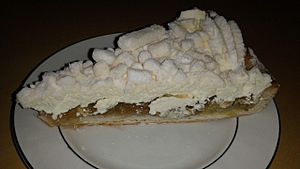Limburgian cuisine facts for kids
Limburgish cuisine is the traditional food from the Limburg region. This area is unique because it's different from other parts of the Netherlands and Belgium. For example, the southeast part of Limburg has hills, unlike the flat landscapes usually found in the Netherlands. Also, the Limburgish language is sometimes seen as its own language, not just a dialect of Dutch.
Because of its special landscape, Limburgish food includes a lot of game meat, especially during hunting season. The northern part of Limburg is flat and is the biggest area in the Netherlands for growing asparagus. In the southwest, you'll find a place called Haspengouw, which is famous for growing lots of fruit and is known as the fruit basket of Belgium.
What Makes Limburgish Food Special?
Limburg's food traditions are shaped by fishing in its rivers, especially the Meuse, and by farming. The region is also well-known for its many kinds of cheese, like the famous Limburger cheese.
People often describe Limburgish food as "Burgundian." This means you can expect generous portions and a simple, honest presentation. But don't let that fool you – the ingredients are high-quality, and the food is prepared with great care.
Popular Snacks and Drinks
Deep-fried chipped potatoes, called fritten in Limburgish, are a very popular snack. Unlike the thinner "French fries" you might find in some fast-food places, Limburgish fries are thicker (about 12–15 mm). They are usually fried in suet (animal fat), similar to Belgian fries.
Limburg is also known for its beer and a traditional spirit called Jenever. Hasselt, the capital of Belgian Limburg, even has a National Jenever Museum!
Limburg produces many different kinds of beers for a relatively small region. Each type of beer often has its own special glass. Many local dishes even include beer as an ingredient. Some well-known breweries in Limburg include Alken-Maes, Lindeboom, Brand, Gulpener, Christoffel, Leeuw, Hertog Jan and Alfa. Many of these breweries use water from the Meuse River. However, Gulpener and Alfa use water from their own wells in the hilly southeast.
Achel brewery, also known as Brouwerij der Sint-Benedictusabdij de Achelse Kluis, is a special Trappist brewery in Limburg. It's the smallest of the seven breweries officially approved to make Trappist beers. It's located in the Abbey of Saint Benedict in Achel, Belgium, and brews five different kinds of Trappist beers.
Famous Limburgish Dishes
Here are some of the most popular and unique dishes you might find in Limburg:
- Konijn in beer (or lapin à la bière): This dish is rabbit cooked in beer, usually a sour beer.
- Limburgse vlaai: This is the most famous dish from Limburg. It's a large, round pie filled with fruit marmalade or other fillings. It's so well-known that it's simply called "Limburgse vlaai" (Limburgish pie).
- Beef dishes: Beef is the most common meat used in Limburg. A popular beef dish is Tête de veaux, which is beef served with mushrooms and a tomato-based sauce.
- Mestreechter stroeap: This is a thick, dark brown syrup made from pears and apples. It's a sweet treat often used in various ways.
- Asparagus: In spring, asparagus is so popular in Limburg that it's called the "queen of vegetables." Traditionally, asparagus is eaten with ham, hard-boiled eggs, boiled potatoes, and a sauce made from melted butter.
- Limburger cheese: This cheese comes from the historical Duchy of Limburg. It's famous for its strong smell! The same type of bacteria that gives Limburger cheese its unique aroma is also found on human skin and contributes to body odor.
- Herve cheese: This is a specific type of Limburger cheese made in the Land of Herve.
- Nonnevotte: These are a type of round doughnut. They are sometimes eaten on New Year's Eve, but they are most commonly enjoyed during the Carnaval celebrations.
- Zoervleis: Fries are often ordered with this traditional Limburgish dish. Zoervleis is a sweet and sour stew. It was traditionally made with horse meat, but today it's often made with cow meat.
- Head cheese (hoofdkaas or kopkieës): This dish is known by different names and variations in the region. In Limburgish, hoofdkaas or kopkieës means "head cheese." It's eaten on bread or with Limburgish sausage as a starter. There's a red, sweet version and a slightly sour, grey version. In Belgian Limburg, it's also called kop or kopvlees, meaning "meat from the head."
- Balkenbrij: This is a unique dish made from the stock left over after making sausages like liverwurst. It's boiled with flour (and sometimes blood, which makes it dark), bacon, and other parts of the animal like liver, kidney, and lungs. These ingredients are cooked, ground, and then cooked again with flour or oatmeal and a special spice mix called "rommelkruid." This spice mix includes ingredients like liquorice, sugar, anis, cinnamon, clove, and ginger. The mixture is then poured into a bowl and cooled to form a loaf. Slices of the loaf (about 1 cm thick) are covered in flour and fried. There are many different recipes for Balkenbrij across Limburg.


